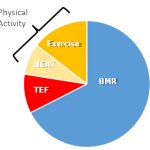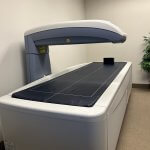The Future of Fitness: Exploring Nutrition and Body Composition Analysis with Technology
The Naked Truth About Body Composition
Don’t Worry, You Can Keep Your Clothes On
Welcome to the world of body composition analysis, where numbers and percentages reign supreme. If you’ve ever wondered about the makeup of your body beyond just weight, then you’re in the right place. Whether a fitness enthusiast or a health professional, understanding your composition is crucial to achieving your health and fitness goals.
The Skinny on Body Composition Analysis
Body composition analysis determines the relative amounts of components that make up the human body, such as fat, muscle, bone, and water. This type of analysis can provide valuable information about an individual’s health status and is becoming increasingly popular in the world of health and fitness.
This blog will explore the techniques and technologies used to measure body composition, focusing on the current gold-standard methods. We’ll also take a closer look at the role of this analysis in nutrition and answer some common questions about this fascinating field. So, let’s dive in and uncover the naked truth about body composition analysis!
What is Body Composition Analysis?
Definition of Body Composition
Body composition refers to the relative proportion of tissues that make up the body, such as fat, lean body mass, organs, bone, and total body water. Understanding is essential because it can provide insights into an individual’s health, fitness, and health risks for chronic diseases.
Importance of Measuring Body Composition
Measuring body composition is vital for many reasons. For example, individuals who are overweight or obese may have a higher percentage of body fat mass and a low amount of fat free body mass, which can increase the risk for conditions such as heart disease, diabetes, and certain types of cancer. Conversely, underweight individuals may have a lower percentage of muscle mass, which can affect their strength, mobility, and overall quality of life.
Techniques for Body Composition Analysis
There are several techniques for analyzing body composition, each with its strengths and weaknesses. Here are some of the most common methods:
- Dual Energy X-ray Absorptiometry (DEXA): DEXA is considered the gold-standard method for measuring body composition. It uses a low-dose x-ray to accurately measure the density of different tissues in the human body, including bone, body fat, and muscle. DEXA is highly accurate and can provide detailed information about where fat and visceral fat is distributed throughout the body.
- Air Displacement Plethysmography (ADP): ADP, also known as the BodPod test, measures body composition by calculating the amount of air displaced by the body. This method is highly accurate and is often used in research settings.
- Bioelectrical Impedance Analysis (BIA): BIA measures body composition by sending a small electric current through the body and measuring how easily the current flows through different tissues. BIA is non-invasive and relatively inexpensive, but it may not be as accurate as other methods. Most popular scales and Inbody Technology use bioelectrical impedance analysis
- Skinfold Thickness Measurements: This method involves using calipers to measure the thickness of skinfolds at various points on the body. Body fat measurements can be used to estimate body fat percentage, but the accuracy of this method can vary depending on the technician’s skill in conducting a body composition test.
- Hydrostatic Weighing: Hydrostatic weighing, also known as underwater weighing, measures body density by weighing an individual on land and then again while submerged in water. This method can be highly accurate but uncomfortable and impractical for some individuals.
It’s important to note that no single method is perfect, and each has its limitations. Combining techniques may provide a more comprehensive assessment of an individual’s body composition.
Body Composition Analysis in Nutrition
Importance of Body Composition Analysis in Nutrition
Body composition analysis is an essential tool in the field of nutrition. It helps to determine a person’s overall health and risk for developing chronic diseases. In addition, body composition analysis is essential in identifying the type of mass a person carries and the amount of muscle, fat, and bone in their body.
Relationship Between Body Composition and Nutrition
Body composition and nutrition are intimately connected. For example, someone with a high percentage of body fat may be at a higher risk for developing cardiovascular disease, type 2 diabetes, and other chronic conditions. On the other hand, someone with a high percentage of muscle mass may have a faster metabolism and be able to burn more calories at rest.
Using Body Composition Analysis to Personalize Nutrition Plans
Body composition analysis allows nutritionists to personalize nutrition plans for their clients based on their unique body composition. By understanding a person’s body composition, a nutritionist can tailor their recommendations to help them achieve their goals: losing weight, gaining muscle mass, or improving overall.
Importance of determining daily caloric needs
Knowing our daily caloric needs is essential to maintaining a healthy weight and achieving our fitness goals. It is the foundation of a successful diet plan and weight management strategy. Daily caloric needs refer to how many calories an individual needs to consume daily to maintain their current weight. If you consume more calories than your daily requirement, you will gain; if you consume fewer calories, you will lose. Thus, determining your daily caloric needs is crucial to achieving your body weight goals.
Advantages of using technology for calculating daily caloric needs
Technology has made it easier to calculate daily caloric needs. Gone are the days when one had to rely on a complicated formula to determine how many calories one should consume daily. Nowadays, several mobile applications and websites can help determine the total calories an individual needs based on age, gender, height, weight, and physical activity level. The use of technology has made it easier and more accurate to determine daily caloric needs, which can result in more effective weight management strategies.
Wearable devices are becoming increasingly popular as a tool to track daily caloric needs. These devices, worn on the body, are designed to monitor physical activity, sleep, and other daily metrics. Using various sensors and algorithms, wearable devices track different types of physical activity, such as steps taken, distance covered, and calories burned. Some devices also monitor heart rate, sleep patterns, and other metrics to estimate a person’s daily caloric needs based on age, gender, weight, and activity level.
Some popular examples of wearable devices for tracking calories include the Fitbit, Apple Watch, Garmin, and Oura. The Fitbit is designed to be worn on the wrist and tracks steps taken, calories burned, and other metrics. The Apple Watch includes various health and fitness features, such as a heart rate monitor, GPS tracking, and tracking calories burned during different activities. Garmin offers a range of wearable devices for monitoring physical activity, including GPS watches and fitness trackers, while Oura focuses on tracking sleep and recovery metrics.
Wearable devices can be a convenient and easy-to-use tool for tracking physical activity and estimating daily caloric needs. They provide real-time feedback on physical activity and calorie intake and can help motivate people to be more active and make healthier choices. However, wearable devices can be expensive to purchase and maintain, may not be accurate in all situations, and rely on self-reporting of food intake, which may not always be accurate. Considering the potential pros and cons before investing in one of these devices is crucial.
Testing with Professional Services.
Professional services that use technology to calculate daily caloric needs are another option for those who prefer a more personalized approach. These services typically involve a consultation with a nutritionist or dietitian who will use various measurements and assessments to determine an individual’s caloric needs. Some examples of professional services that use technology for this purpose include metabolic testing, indirect calorimetry, and RMR (resting metabolic rate) testing. The advantage of using these services is that they can provide a more accurate and personalized assessment of an individual’s caloric needs. However, the cost and accessibility of these services may be a barrier for some individuals.
In conclusion, body composition analysis is crucial in achieving health and fitness goals. The gold-standard methods for body analysis, such as DEXA and ADP, accurately measure and provide valuable information about an individual’s overall health. Combining techniques may provide a more comprehensive assessment culminating in the desired body composition results. Nutritionists can use body composition analysis to personalize nutrition plans for their clients, tailoring recommendations to help them achieve their weight goals. Determining daily caloric needs is essential for maintaining a healthy weight, and technology has made it easier and more accurate to calculate. Wearable devices are increasingly popular for tracking daily caloric needs, monitoring physical activity levels, and providing valuable feedback. Overall, with the help of technology and body composition analysis, individuals can achieve their health and fitness goals with greater accuracy and efficiency.



 g, and becoming fit.
g, and becoming fit.



